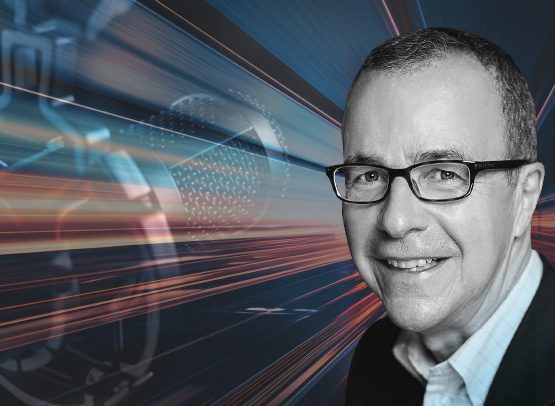A tidal wave of new tech is here. Advice from Julian Mills? “Never, ever, ever get comfortable. Because something’s going to change. And you don’t know what that will be.”
An AI revolution has erupted beneath our feet. ChatGPT has recently announced GPT-4, its latest operating consciousness that is uncannily, exponentially, more powerful than its parent iteration. As we brace for the next world-shifting announcement, we know that today’s landscape will be outdated by the time you’re finished reading this article, and even more obsolete in just a month.
This is an exciting time for technology, but it’s an unsettling era for many communicators, who feel, suddenly, all too replaceable.
To try to uncover insight, we spoke to an expert who seems to actively seek the wisdom that comes from disruption: Julian Mills, VP of Product & Marketing at Extranet User Manager and previously Managing Director at CPP Investment Board, one of the world’s largest private equity investors. As a leader who has seen it all, Julian began his career as a magazine editor, receiving a national magazine award for technical feature writing. He went on to re-establish the brand in Canada for a European-based imaging system manufacturer, creating a marketing and go-to-market strategy that enabled management of industry-wide digital disruption. While he was Head of Corporate Intranet at BMO, he led a team that built a digital platform that provided millions of dollars in value.
He tells us of his roots in print publishing – how he was there when digitization made a stagnant industry unrecognizable overnight. “I was talking to printers who were seeing people walk in with disks, and they didn’t know what to do,” Julian tells us. “Print was one of the first industries to be fully disrupted, and there were some people at the time who were in total denial it was happening.”
From print to digitization to AI, Julian rides seismic shifts in technology, always scouting ahead. And as some communicators grow more anxious about our value in the world, Julian compares our roles to oracles around a campfire. Our storytelling guides people through uncertain times. Today, technology is the new campfire.
“People will always want stories,” he says. “But the way they get these stories is going to change. If you get too attached to the technology, you’re in trouble. For the rest of your career, don’t get too comfortable. Because something’s going to come for you.”
In that light, this is both frightening and freeing.
We were honored to host this conversation between Scott Macdonald, VP of Audience Experience at Livewire, and Julian Mills. Their thoughts bridge together communication with change and with disruptive technology – and, importantly, with insight into our comfort levels, how we should always both seize the moment and prepare for tomorrow.
The following interview has been edited for length and clarity.
Interview with Julian Mills, VP of Product & Marketing at Extranet User Manager
As only a seasoned communicator would, Julian starts the interview with five key themes already summarized.
Julian Mills: Before we start, this is a huge topic. I came up with these key themes, “five things we have to do right now,” so we don’t get lost in the philosophy.
- Seize the moment. Employee Experience (EX) has never been more important, and there have never been better solutions. But get a strong focus on how you add value regardless of technology. Don’t lose sight of that.
- Learn with focus. There is an infinite amount of information out there to learn, but you have to focus on strategy and choose what to learn.
- Be at the table. Comms is often not at the table. By the time they’ve been given an assignment, their only option is to think about it through tactics and not set the strategic agenda.
- Own your tech stack. Comms has largely worked off of someone else’s tech stack. Often a license is brought in for productivity and collaboration, and then the Comms workload is put on top of that because it’s cheaper. It’s time for Comms to own their own stack.
- Fill the void. This is where it comes together. If Comms is chasing tactics and not at the decision table and not learning with focus, then a void is going to be made. Comms and HR should be front and center to fill it.
Scott Macdonald: I love that this is such a wake-up call. Comms needs to hear this. You play this role that bridges comms, tech, and disruption together so effortlessly, and all the intersections people don’t think about. Where does that come from?
JM: One of the reasons I'm able to be comfortable with disruption is that my early experience taught me that it doesn't allow for complacency. You can never settle in and get comfortable, and you have to embrace the insights provided by failure. I'm comfortable with disruption because I've made so many mistakes in my life. In my experience, as soon as you get complacent, you’re in trouble.
SM: In your work, you talk a lot about where you deliver value as a communicator. For you, communicators don’t just execute information transfer, they create experiences. In many ways, the entire workplace experience is now a focus for everyone.
How are you thinking about that today? What is the communicator’s role?
JM: There has never been a bigger need for concise, memorable stories. People aren’t sure where they should work. They don’t know what their purpose is. We had the Great Resignation. Tech companies have laid off hundreds of thousands of people. Right now, an individual needs a story, and a company needs a story.
The future for communicators is still in narrative. The people who can tell concise stories that have a beginning, middle, and end in six seconds are the ones who succeed.
I would challenge corporate communicators to say: Have you lost sight of where you really add value? Are you getting too drawn to the bureaucracy? Are you too excited about writing PowerPoint decks or hosting online townhalls where people aren’t paying attention?
It's hard to tell a short story in 2 minutes. It's way easier to write up a 20-page PowerPoint deck.
SM: I’ll add that there’s such a focus on new technology. I get that question all the time: “What’s the coolest, newest thing?”
But therein lies the opportunity for the communicator. You can rise above and think in terms of story, strategy, and where you’re taking the audience.
The question becomes: How do I leverage these channels to the best effect? It’s a whole different way of thinking.
JM: Let’s put it this way: Hemingway is still being read because he knew how to tell great stories. Not because he had a great typewriter.
What I’m really focused on is the enablement layer: How is communication enabled? The enablement layer, the technology, is going to change, but underneath – the driver of communication – is not. The questions then become:
How do you know enough about the enablement layer to add value?
How do you not get distracted by it so that you’re always looking ahead?
Once I learned this, I was able to catch the wave before it formed.
SM: I really feel for the communicators in all this. We’ve gone through the shift where there was so much excitement about all these tools that were available. But over the past 7-8 years, there has been this unintentional democratization of platforms, where every department head can just stand up a platform to solve a business problem.
Now, Comms is dealing with the overwhelm. How do they even know what your channels are? How do they know where people are hanging out and how do they reach them in this soup of technology that's been turned on over time?
JM: I think the really big question for communicators is: Where's the real home screen? I heard there are 187 apps and programs that the average company has its employees engage with. The number of apps is inhumane.
Comms needs to be more assertive within the organization and stake a claim to their own tech stack.
Or, if you’re getting access to a tech stack that was brought in for another reason – e.g., to enable productivity or facilitate collaboration – establish a governance model. It’s an investment of time, but that means you have a voice in what your policies are.
The second thing: Get workplace analytics on how much time people are spending on each platform and on consuming content.
What hasn't changed is the need to engage and tell engaging stories.
What has changed is communicators must become more of a marketer and start to analyze: Where are people putting their attention? How do I use my strategic awareness? When should somebody be paying attention?
SM: This is where I get excited about AI. Once this technology is fully in play, there’s a huge opportunity to have AI tie together these data sets and platforms so that you can draw connections. If an AI can learn everything about employee data sets, where people spend time and where they’re struggling, there’s a host of privacy and moral concerns, but wouldn’t it be amazing information to have?
JM: To me, this is the most exciting opportunity right now. But it goes back to my theme, “Learn with focus.” The amount of information out there is unbelievable. So what does a communicator or an HR person need to know about AI?
For instance: What are the repetitive tasks that a machine might do better than us? How much capacity would that free up if the repetitive and functional communications are being taken care of?
AI also does testing really well. Could we get better results if our communications were written in this way vs. this way?
SM: There’s a tidal wave coming. There’s an opportunity for Comms to really elevate and become a more strategic entity in an organization.
JM: Comms is at its best when it's not being forced to execute tactics against a poorly thought-through strategy.
Organizations that do well have got senior communications at the table with a strong voice when an organization is trying to figure out how to deal with problems.
One of my favorite leadership quotes: If you want a group of people to sail a boat to another island, you don't teach them how to build a boat. You give them the desire to sail.







